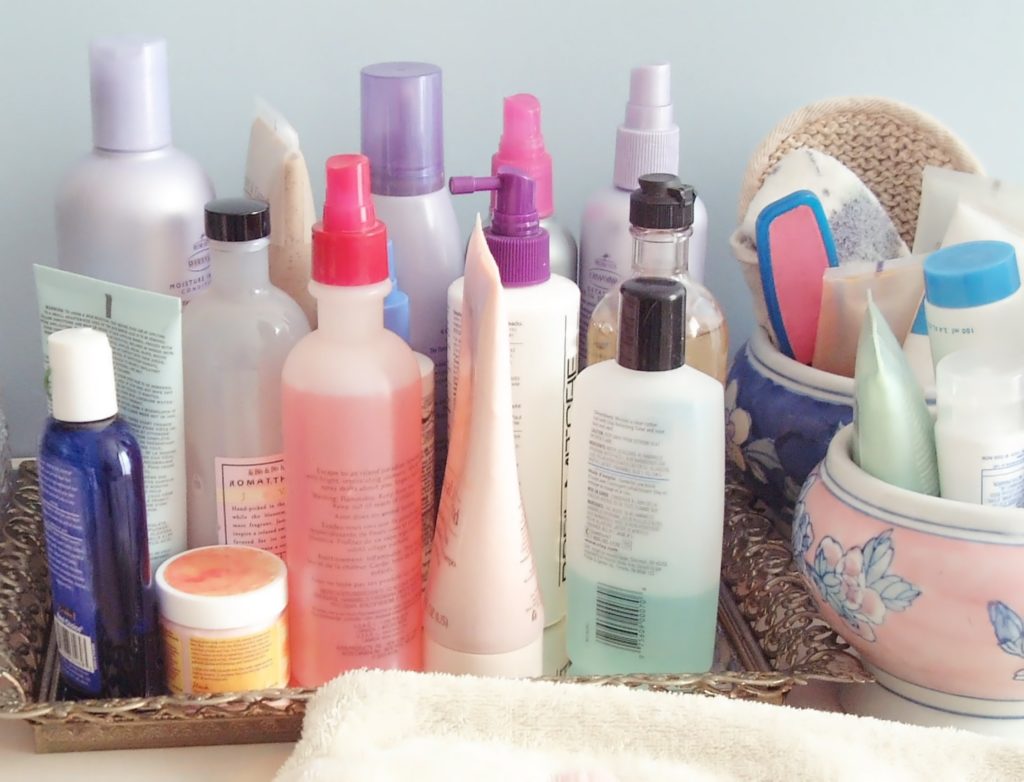A new study—the Sister Study—by researchers at the U.S. National Institutes of Health (NIH) studied 33,947 women over an average of 11 years all using chemical hair straightening products more than four times per year. The study found that women who use these products were two-and-a-half times more likely to develop uterine cancer.
The researchers also studied other hair products, including perms, hair dyes, and highlights, but could not link them to uterine cancer.
Researchers Conducted the Study of Hair Products Linked to Cancer

The researchers found 33,947 women between 35 to 74 years of age from 2003 through 2009. The group was racially and ethnically diverse and originally started with 50,884 women.
Eligibility requirements to participate in the study were:
- Had at least one sister who received a breast cancer diagnosis
- Lived in the United States, including Puerto Rico
- Had no history of uterine cancer
Response rates for follow-up health questions were 90 percent. Those who had disqualifying traits such as having uterine cancer prior to enrolling in the study, being unsure of uterine cancer history, having a relative who developed uterine cancer, having a hysterectomy prior to enrollment, not using hair products, and not responding to the follow-up questions were eliminated, resulting in 33,947 women who completed the study.
The women had to have used hair products in the 12 months prior to enrollment in the study, including straighteners, hair dyes, pressing products, relaxers, body waves, and permanents. Over 10.9 years, the study found that 378 women who used straighteners were diagnosed with uterine cancer. Those who used straighteners more often (more than four times in the previous 12 months) were even more likely to develop uterine cancer.
Other products, including permanents and hair dyes, did not develop uterine cancer, breast cancer, or uterine fibroids at such high rates.
How Does Hair Straightening Work?
Your hair contains a protein called keratin, which has sulfide molecules. When the sulfides pair, they create a disulfide bond. Every bond bends the hair when the two sulfide molecules try to pair, causing the hair to curl. Those with very curly hair have more disulfide bonds in each strand.
To straighten hair, you have to break the disulfide bonds. Hairdressers use three ways to do this:
- Chemical relaxers use strong chemicals that break the disulfide bonds. In many cases, the chemical is lye, which can cause burns on your scalp and damage your hair. After application, the chemical stays on your hair for 20 minutes, then the hairdresser rinses it out and neutralizes it. During the process, the chemicals could burn your scalp.
- Japanese hair straightening also uses chemicals during a process called thermal reconditioning. The chemicals break the disulfide bonds. After application, the hairdresser rinses your hair, blow dries it, and straightens it with a flat iron. Once the hair is straightened, the hairdresser adds a neutralizer to your hair.
- Keratin hair straightening, sometimes referred to as Brazilian blowouts, uses chemicals but is not as damaging as the first two methods. This method is not permanent. Hairdressers apply a layer of keratin, then iron the hair.
You can also buy hair straightening kits over the counter and straighten your hair yourself.
Common Hair Straightening Brands and Companies
Several companies make products used for straightening hair.
Some common brands include:
- Africa’s Best
- African Pride
- Bantu
- Crème of Nature
- Dark & Lovely by L’Oreal
- Just for me by Strength of Global LLC
- Luster’s
- Mizani Relaxer
- Motions
- ORS Olive Oil
- Olive Oil Girls by Namaste
- Optimum by L’Oréal
- Soft & Beautiful Motions by Strength of Global LLC
- TCB Naturals by Strength of Global LLC
- Ultra Precise
- Ultra Sheen Supreme
What Cancers Do Hair Products Cause?
The cancers that researchers investigated or are investigating for the possibility of a link to hair straighteners include:
Uterine Cancer
Around 65,000 females develop endometrial carcinoma—uterine cancer—every year, and that is just in the United States. Over 90 percent of the cases are of endometrial origin. The mean age of women who develop uterine cancer is 61, and doctors most commonly diagnose it when women are in their 70s.
When compared to those who do not use hair straighteners, only 1.64 percent of women who don’t use them develop uterine cancer by the time they reach 70. About 4.05 percent of women who use hair straighteners develop uterine cancer by age 70.
Breast Cancer
Another study published in the Carcinogenesis Journal by Oxford University found that black women who used hair straighteners with a lye base at least seven times per year over a 15-year period were 30 percent more likely to develop breast cancer.
The data is from Boston University’s Black Women’s Health Study, which reviewed the diagnoses of 50,000 African American women. The study took place over 25 years. Ninety-five percent of the women in the study said they used lye-based hair straighteners between 1997 and 2017. Of those, 2,311 developed breast cancer.
Uterine Fibroids
The National Institute of Health studied 46,000 women over eight years. The women were of all races, aged between 35 and 74. The researchers in this study found that African American women were 45 percent more likely to develop breast cancer connected to fibroid development.
Another study in the American Journal of Epidemiology studied 23,580 black women and found they were up to three times more likely to develop uterine fibroids. Researchers conducted the study from 1997 through 2009.
Qualifications for a Hair Straightener Cancer Lawsuit
To qualify for a hair straightener cancer lawsuit, you may must have:
- Used chemical-based hair straightening products.
- Started using it as an adolescent in most cases. Some could start later in life and still develop cancer, so always check with a product liability attorney.
- Used hair straightening products for several years.
- A uterine cancer diagnosis.
- A breast cancer diagnosis.
- A diagnosis of uterine fibroids.
Also, if you suffered scalp burns, you should check your eligibility, though the scalp burns are not required to file a lawsuit.
Additionally, if your family has a history of uterine cancer not caused by hair products, you might not be eligible. Always check with a product liability lawyer experienced in hair products cancer lawsuits to ensure qualification—never assume that you are or are not qualified.
Proving a Hair Products Liability Case
To succeed in recovering damages for cancer-related to hair straighteners, you must meet the elements of a product liability case.
Such elements include:
- The company making the hair straightener has a duty to provide safe products.
- The company making the hair straightener breached that duty. If the company did take measures to protect its customers once it learned of the dangers of the product, it breached its duty to provide safe products.
- As a result of the company’s breach of duty, you suffered injury (cancer) or death.
- Your cancer or the death of a loved one from uterine cancer was a direct cause of using hair products known to cause cancer.
To prove the use of hair straighteners or other hair products caused your cancer or the death of a loved one from cancer, your attorney might hire medical experts to testify to the connection between cancer and the hair products.
The hair products must have the chemicals researchers found to cause uterine cancer, breast cancer, or uterine fibroids.
Recovering Damages After a Uterine Cancer Lawsuit or Settlement
You may recover compensatory damages if you win a hair products lawsuit. Compensatory damages come in two forms: Economic damages and non-economic damages.
Economic Damages
Sometimes referred to as special damages, economic damages have a monetary value and include:
- Medical expenses, including chemotherapy, radiation, surgeries, doctors’ appointments, follow-up appointments, prescriptions, and prescribed over-the-counter medications
- Medical aids
- Rehabilitation costs
- Psychological therapy
- Death-related expenses if the cancer killed a loved one, including funeral and burial expenses, cremation expenses, and probate attorney’s fees and costs
Non-Economic Damages
Sometimes referred to as general damages, non-economic damages include:
- Pain and suffering, including emotional distress
- Loss of income
- Loss of future earning capacity
- Loss of companionship if you can no longer enjoy time with your family or take part in family activities and events
- Loss of consortium if you can no longer enjoy a physical relationship with your spouse
- Loss of quality of life if the cancer or treatment causes you to take prescriptions for the rest of your life or otherwise hinders your life
The amount of compensation you recover depends on several factors, including the severity of the cancer, how the treatment affects you, and whether the cancer caused the death of a loved one.

How Long Does It Take to Get a Settlement or Money From Litigation?
Receiving your money after fighting a hair products cancer lawsuit depends on whether you are able to settle, if you win an individual lawsuit, or if you are involved in a class action lawsuit. Settlements and lawsuits can take months or even a year or more, depending on the circumstances of your case and the type of lawsuit.
However, it takes a few weeks to receive your money once you win a settlement or individual lawsuit. Once the insurance company agrees to a settlement or the court orders the insurance company to pay your damages, an attorney—usually the defendant’s attorney—has to draft a settlement agreement or final judgment.
They then forward the settlement agreement or proposed final judgment to your attorney for review. If you and your attorney agree that it is correct, you sign the settlement agreement, or the defendant’s attorney forwards the final judgment to the court for execution. The judge signs the final judgment if it meets with their approval, then files it with the court and forwards signed copies to your attorney and the defendant’s attorney.
Once the defendant’s attorney receives the signed settlement agreement or signed final judgment, the insurance company processes the paperwork. The defendant’s attorney drafts additional documents you must sign, including any waivers, then forwards the package to your attorney. After you sign any additional documents, they will forward the check to your attorney.
When your attorney receives the check, they must deposit it in an escrow account. They can’t take the next steps until the check clears the bank, which could take up to 14 days, depending on the amount.
When the check clears, your attorney pays any outstanding medical expenses you have. Depending on the circumstances, part of the money you received might go to reimbursing your health insurance company. The attorney then takes their agreed-upon fees and costs and cuts you a check for the difference. Once you receive the check, you can deposit it and use it as you please.
How to Pay for a Products Liability Lawyer and Medical Expenses
You don’t pay for a product liability lawyer unless you win your case. Your initial case evaluation is free and without obligation. And if you don’t win your hair products liability case, you don’t pay attorney’s fees.
You can use your health insurance to cover medical expenses if you are just starting treatment. Once your lawyers get your case started, they could help you find the medical care you need and, if necessary, write a letter of credit asking medical professionals to hold off on collections while you are involved in settlement negotiations or have filed a lawsuit.
If you suffered uterine cancer, breast cancer, or uterine fibroids and used hair products, including hair straighteners, contact a product liability attorney for your free case evaluation.